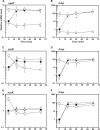Corynebacterium glutamicum ArnR controls expression of nitrate reductase operon narKGHJI and nitric oxide (NO)-detoxifying enzyme gene hmp in an NO-responsive manner
- PMID: 24142248
- PMCID: PMC3911137
- DOI: 10.1128/JB.01004-13
Corynebacterium glutamicum ArnR controls expression of nitrate reductase operon narKGHJI and nitric oxide (NO)-detoxifying enzyme gene hmp in an NO-responsive manner
Abstract
Corynebacterium glutamicum ArnR is a novel transcriptional regulator that represses expression of the nitrate reductase operon narKGHJI and the nitric oxide (NO)-detoxifying flavohemoglobin gene hmp under aerobic conditions. In a previous study, we showed that ArnR-mediated repression is relieved during anaerobic nitrate respiration, but we could not pinpoint the specific signal that ArnR senses. In this study, we show that in the absence of nitrate, ArnR-mediated repression is maintained under anaerobic conditions. The derepression in response to nitrate is eliminated by disruption of narG, suggesting that ArnR senses nitrate derivatives generated during nitrate respiration. Specifically, the hmp gene is upregulated in the presence of nitrite or nitric oxide (NO) in an ArnR-dependent manner, although the response of narK appears to be greatly affected by ArnR-independent regulation. In vitro binding of ArnR to the narK and hmp promoter regions is more strongly inhibited by NO than by nitrite. We previously showed that the UV-visible spectrum of ArnR is typical of a Fe-S cluster-containing protein. Site-directed mutagenesis of each of three cysteine residues, which are possibly involved in coordination of the cofactor in the ArnR protein, results in loss of the binding of this protein to its target promoters in vitro and eliminates the repression of the target genes in vivo under aerobic conditions. These observations suggest that the cofactor coordinated by these three cysteine residues in the ArnR protein plays a critical role in the NO-responsive expression of the narKGHJI operon and the hmp gene.
Figures







Similar articles
-
ArnR, a novel transcriptional regulator, represses expression of the narKGHJI operon in Corynebacterium glutamicum.J Bacteriol. 2008 May;190(9):3264-73. doi: 10.1128/JB.01801-07. Epub 2008 Feb 22. J Bacteriol. 2008. PMID: 18296524 Free PMC article.
-
Regulation of the nitrate reductase operon narKGHJI by the cAMP-dependent regulator GlxR in Corynebacterium glutamicum.Microbiology (Reading). 2011 Jan;157(Pt 1):21-28. doi: 10.1099/mic.0.044552-0. Epub 2010 Sep 23. Microbiology (Reading). 2011. PMID: 20864477
-
Anaerobic growth of Corynebacterium glutamicum using nitrate as a terminal electron acceptor.Appl Microbiol Biotechnol. 2007 Jun;75(4):889-97. doi: 10.1007/s00253-007-0879-y. Epub 2007 Mar 9. Appl Microbiol Biotechnol. 2007. PMID: 17347820
-
Nitrate regulation of anaerobic respiratory gene expression in Escherichia coli.Mol Microbiol. 1993 Aug;9(3):425-34. doi: 10.1111/j.1365-2958.1993.tb01704.x. Mol Microbiol. 1993. PMID: 8412692 Review.
-
Phylogenomics of Mycobacterium Nitrate Reductase Operon.Curr Microbiol. 2015 Jul;71(1):121-8. doi: 10.1007/s00284-015-0838-2. Epub 2015 May 17. Curr Microbiol. 2015. PMID: 25980349 Review.
Cited by
-
ArnR binds a [4Fe-4S] cluster and indirectly senses anaerobicity in Corynebacteria.Metallomics. 2025 Aug 5;17(8):mfaf026. doi: 10.1093/mtomcs/mfaf026. Metallomics. 2025. PMID: 40690261 Free PMC article.
-
Binding of a single nitric oxide molecule is sufficient to disrupt DNA binding of the nitrosative stress regulator NsrR.Chem Sci. 2024 Oct 15;15(45):18920-32. doi: 10.1039/d4sc04618h. Online ahead of print. Chem Sci. 2024. PMID: 39464610 Free PMC article.
-
Regulation of oxidative stress response and antioxidant modification in Corynebacterium glutamicum.World J Microbiol Biotechnol. 2024 Jul 15;40(9):267. doi: 10.1007/s11274-024-04066-z. World J Microbiol Biotechnol. 2024. PMID: 39004689 Review.
-
Fe-S proteins that regulate gene expression.Biochim Biophys Acta. 2015 Jun;1853(6):1284-93. doi: 10.1016/j.bbamcr.2014.11.018. Epub 2014 Nov 20. Biochim Biophys Acta. 2015. PMID: 25450978 Free PMC article. Review.
-
Exploration of Nitrate Reductase Metabolic Pathway in Corynebacterium pseudotuberculosis.Int J Genomics. 2017;2017:9481756. doi: 10.1155/2017/9481756. Epub 2017 Feb 20. Int J Genomics. 2017. PMID: 28316974 Free PMC article.
References
Publication types
MeSH terms
Substances
LinkOut - more resources
Full Text Sources
Other Literature Sources
Molecular Biology Databases
Research Materials
Miscellaneous

